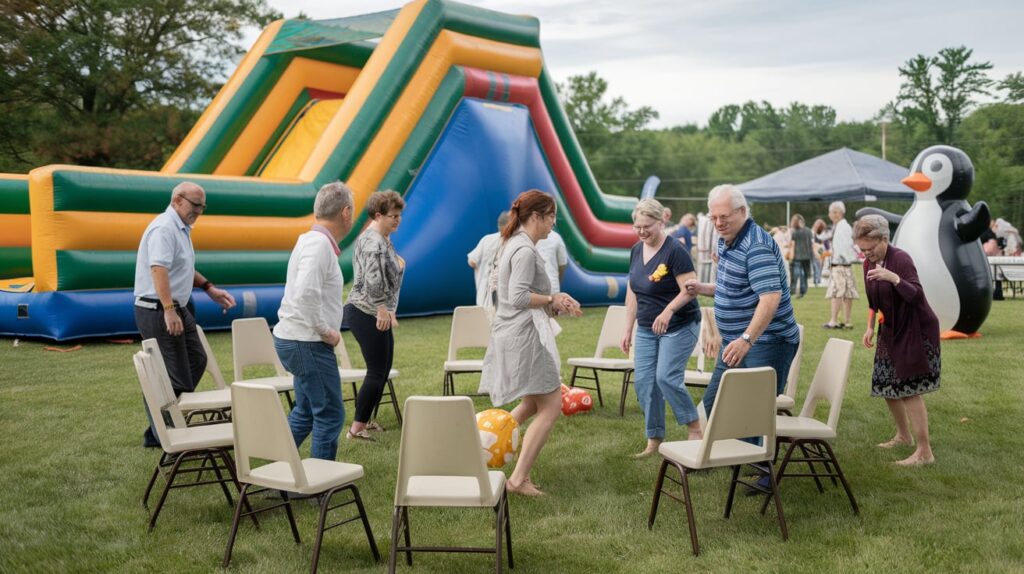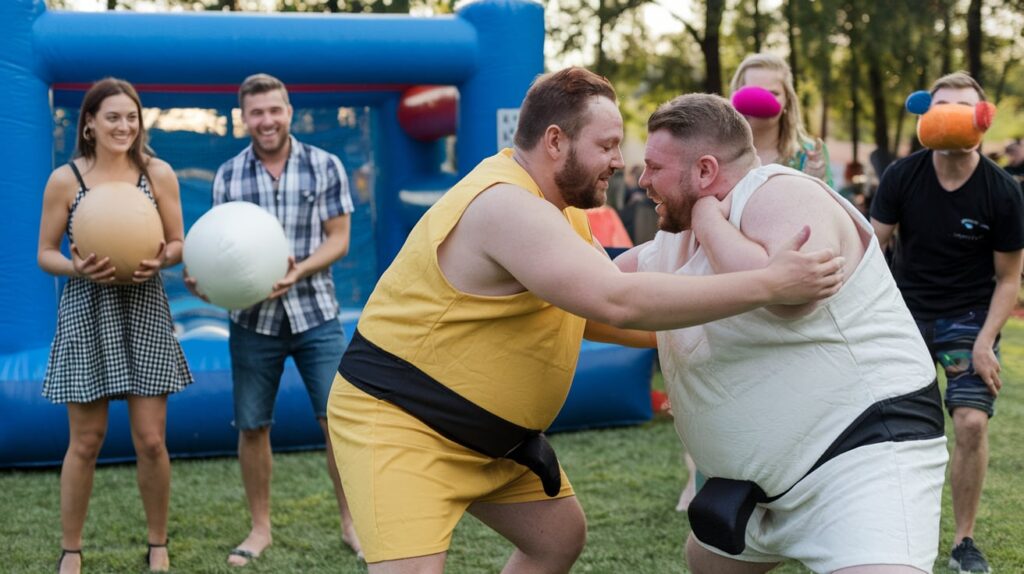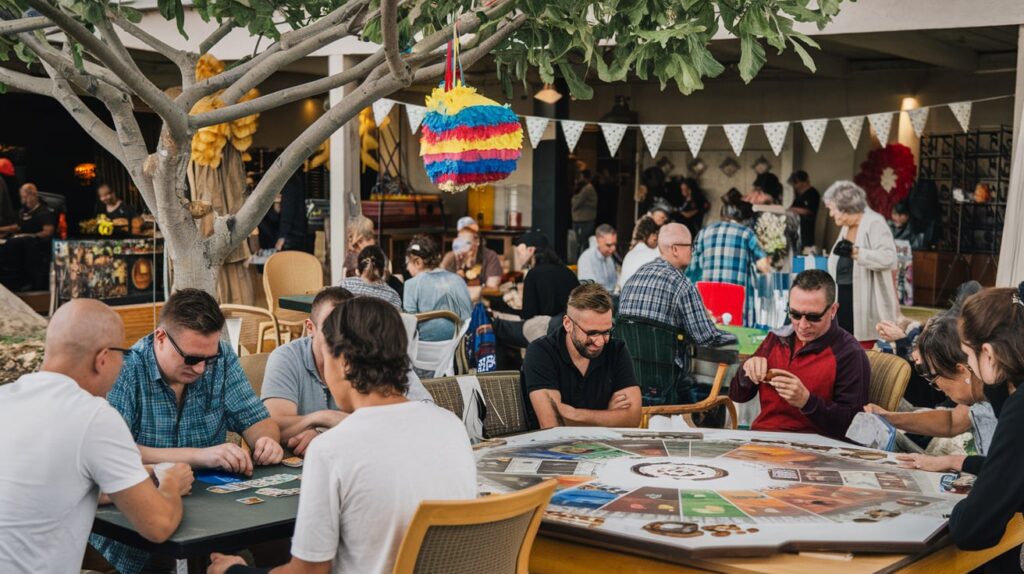Adult Party Ideas Games are essential for creating a lively and engaging atmosphere at any gathering. These games are designed to entertain guests while encouraging social interaction and laughter. Popular options include classic party games like charades and Pictionary, which can be tailored to suit adult themes or specific interests. Trivia games that challenge participants’ knowledge of pop culture, history, or even personal anecdotes about the host can add a fun twist. For a more interactive experience, consider murder mystery games that allow guests to assume unique characters and work together to solve a thrilling plot.
Related Post –
Additionally, card games like Cards Against Humanity or drinking games can spark humor and friendly competition among attendees. Incorporating themed activities, such as a cocktail-making contest or a dance-off, can further enhance the experience. Ultimately, adult party games serve as a great icebreaker, ensuring that everyone has a memorable time while forging connections and enjoying each other’s company.
Adult Party Ideas
Here’s a list of ideas for organizing an Adult Party, covering a variety of categories to help create a memorable event:
🎉 1. Invitations
- Digital Invitations: Use email or apps like Evite.
- Themed Paper Invitations: Send customized invitations matching the party theme.
- Social Media Invitations: Use platforms like Facebook Events.
🎈 Decorations
- Balloons & Streamers: Match colors to the party theme.
- Centerpieces: Flowers, candles, or glass bowls filled with decorative items.
- String Lights: Create a cozy atmosphere.
- Photo Wall: Set up a corner with props and a backdrop.
- Themed Decor: Depending on your party theme (Tropical, Vintage, Hollywood, etc.).
🍹 Drinks Station
- Open Bar: Provide a variety of liquor, mixers, and garnishes.
- Signature Cocktail Bar: Offer 2-3 unique specialty drinks.
- DIY Drink Station: Let guests mix their drinks with a variety of options.
- Non-Alcoholic Options: Mocktails, soda, juice, and infused water.
🍽️ Food Ideas
- Appetizer Platters: Cheese boards, fruit platters, or veggie trays.
- Finger Foods: Mini sliders, bruschettas, chips, and dip varieties.
- Buffet Style: Offer tacos, pasta, or sliders with customizable toppings.
- Dessert Table: Cupcakes, brownies, cookies, and a chocolate fountain.
🕺💃 Entertainment Ideas
- Live Music/DJ: Hire a band or a local DJ.
- Karaoke Machine: Encourage guests to sing their hearts out.
- Themed Performers: Magicians, dancers, or impersonators.
- Game Corner:
- Board games or card games.
- Interactive games like beer pong, trivia, or charades.
- Giant Jenga or cornhole for outdoor events.
🧩 Activity Ideas
- DIY Craft Stations: Personalized T-shirts, painting corner, or pottery.
- Photo Booth: Props, funny hats, wigs, and themed backdrops.
- Scavenger Hunt: Organize a scavenger hunt for guests around the house or venue.
- Talent Show: Let guests showcase their hidden talents!
🥂 Theme Ideas
- Hollywood Glam: Red carpet, gold decor, and movie-themed accessories.
- Tropical Paradise: Tiki torches, palm leaves, and tropical drinks.
- Retro/Vintage Party: 70s/80s decor with disco balls and vinyl records.
- Masquerade Ball: Elegant masks, black and gold decor, and sophisticated vibes.
- Casino Night: Poker tables, dice, and fun chips for games.
📦 Party Favors
- Customized Glasses: Personalized shot glasses or tumblers.
- Gift Bags: Include mini bottles, chocolates, and candles.
- Themed Keepsakes: Keychains, picture frames, or custom tote bags.
📝 Miscellaneous Tips
- Music Playlist: Curate a playlist in advance or use streaming services.
- Comfortable Seating: Ensure there are plenty of chairs, sofas, and outdoor seating.
- Lighting Choices: Use dim lights, string lights, or mood lamps.
- Clear Layout: Organize tables, dance floors, and chill areas intuitively.
Adult Party Ideas Games
Here’s a list of Adult Party Games:
- Charades
- Pictionary
- Trivia Night
- Murder Mystery Game
- Cards Against Humanity
- Drinking Games (e.g., Kings, Flip Cup)
- Never Have I Ever
- Scavenger Hunt
- Two Truths and a Lie
- Adult Bingo
Charades
Charades is a classic party game that encourages creativity, teamwork, and lots of laughter. Players take turns acting out a word or phrase without speaking, while their teammates try to guess what it is. This game is not only entertaining but also helps break the ice and brings out everyone’s playful side.
How to Play Charades: Step by Step
Step 1: Gather Materials
- Prepare a List: Create a list of words or phrases to act out. These can include movies, songs, famous people, or everyday actions. You can write them on slips of paper and place them in a bowl or hat for easy access.
Step 2: Organize Teams
- Divide into Teams: Split players into two teams. Each team will take turns sending one member to act out the word or phrase while their teammates guess.
Step 3: Set the Rules
- Time Limit: Decide on a time limit for each round (usually one to two minutes).
- Acting Guidelines: Players cannot speak, make sounds, or use props. They can only use gestures and body language to convey the word or phrase.
Step 4: Start the Game
- Choose a Player: One player from the first team is chosen to act out the first word or phrase.
- Draw a Word: The actor draws a slip of paper from the bowl without showing it to their teammates and has a moment to think before starting.
Step 5: Acting It Out
- Begin Acting: The actor starts performing the word or phrase while their teammates guess. They can use gestures, facial expressions, and movements to communicate.
- Encourage Creativity: Actors can break the word or phrase down into parts if needed. For example, if the word is “basketball,” they might mimic dribbling and shooting.
Step 6: Guessing
- Time’s Up: If the teammates guess the word or phrase correctly before time runs out, the team earns a point. If they fail to guess, the opposing team can have a chance to guess for a point.
Step 7: Rotate Teams
- Alternate Turns: After a round, switch to the other team. Continue playing until everyone has had a turn to act, or set a specific number of rounds.
Step 8: Keep Score
- Tally Points: Keep track of points earned by each team. The team with the most points at the end of the game wins.
Step 9: Celebrate
- Announce the Winner: After the final round, announce the winning team. Consider small prizes or simply celebrate the fun moments shared during the game.
Tips for Success
- Vary Difficulty Levels: Adjust the complexity of the words or phrases based on the players’ ages and familiarity with the subject matter.
- Use Themes: Incorporate themes (like movies, holidays, or specific decades) to add variety and challenge.
- Encourage Participation: Make sure everyone gets a chance to act and guess, ensuring a fun experience for all.
Charades is an entertaining and interactive game that fosters creativity and laughter, making it perfect for gatherings, parties, or family events!
Pictionary
Pictionary is a lively party game that blends creativity with quick thinking, where players aim to convey words or phrases through drawings.
Here’s a detailed, step-by-step guide on how to play:
- Players: Typically played in teams, with a minimum of four players (two teams).
- Materials Needed: A Pictionary game set (which includes a game board, cards with words/phrases, a timer, and drawing supplies) or a DIY version with paper and pens.
Step-by-Step Instructions
- Setup the Game:
- Divide players into two teams, ensuring each team has an equal number of members.
- Place the game board on a flat surface, and set the cards with words or phrases in a stack, face down.
- Have drawing supplies (like a whiteboard, markers, or paper and pencils) easily accessible.
- Decide on the Order:
- Teams will take turns drawing. You can determine which team goes first by a quick method, such as a coin flip or each team drawing a card to see who has the highest score.
- Choose a Drawer:
- For each turn, one player from the team will be designated as the “drawer.” This player will be responsible for illustrating the word or phrase.
- Draw a Card:
- The drawer picks a card from the stack without revealing it to their team. The card contains a word or phrase that they need to depict through drawing.
- The words/phrases are often categorized (e.g., objects, actions, places) and can vary in difficulty.
- Set the Timer:
- Set the timer for a specific duration, typically one minute. This adds urgency and excitement to the drawing.
- Start Drawing:
- When the timer starts, the drawer begins to sketch the word or phrase without using letters or numbers. They can use symbols, simple shapes, or images to convey the meaning.
- If players are using a Pictionary set, they might have different types of cards indicating the drawing style (e.g., one word, phrase, or movie title).
- Guessing:
- Team members attempt to guess the word or phrase based on the drawer’s illustration. Communication is key; teammates can shout out their guesses as the drawer continues to draw.
- If the team guesses correctly before the timer runs out, they earn a point.
- End of Turn:
- Once the time is up, or the team guesses correctly, the turn is over. If the team didn’t guess correctly, the drawer can reveal the answer.
- The other team then takes their turn using the same process.
- Winning the Game:
- Continue alternating turns between teams. The game typically ends when a team reaches a predetermined number of points (e.g., 10 points) or after a set number of rounds.
- The team with the most points at the end of the game is declared the winner.
Additional Tips
- House Rules: Teams can create house rules for challenges or bonus rounds for extra points.
- Encourage Creativity: Drawers should be encouraged to be as imaginative as possible with their sketches to inspire guesses.
- Adapt for Different Ages: Adjust the difficulty of the words based on the ages and skill levels of players.
Pictionary is all about having fun, fostering teamwork, and showcasing artistic flair, even if the drawings aren’t perfect!
Trivia Night
Trivia Night is an engaging and interactive quiz game where participants answer questions from various categories to score points. It often takes place in a relaxed setting, such as a bar or community center, making it a fun way to socialize and test your knowledge.
Step-by-Step Guide to Playing Trivia Night
- Gather Your Team:
- Assemble a group of friends or family members to form a team. A typical team consists of 2 to 6 players, but the size can vary based on the venue’s rules.
- Choose a Venue:
- Find a local bar, restaurant, or community space that hosts Trivia Night. Many establishments have dedicated nights for this activity, so check their schedules.
- Understand the Format:
- Trivia Night usually consists of multiple rounds, each featuring a different theme or category (e.g., history, pop culture, sports). Rounds can have varying numbers of questions.
- Register Your Team:
- Upon arrival, register your team with the host. You may need to provide a team name, which can be humorous or clever, and sometimes pay a small entry fee.
- Obtain a Answer Sheet:
- The host will provide answer sheets, where you will write down your team’s responses. Make sure you have pens or pencils on hand.
- Listen to the Rules:
- Pay attention as the host explains the game’s rules. This may include details about scoring, time limits for each question, and any special rules for bonus rounds.
- Participate in the Rounds:
- The host will read questions aloud, typically allowing a set amount of time (e.g., 30 seconds) for teams to discuss and write down their answers.
- Questions can be multiple-choice or open-ended, requiring teams to either select an option or write their own response.
- Submit Your Answers:
- After each round, submit your answer sheets to the host. They will collect and score them based on correctness.
- Scoring:
- Points are awarded for each correct answer. Some trivia nights may offer extra points for particularly challenging questions or for answering in rapid succession.
- Enjoy the Breaks:
- Between rounds, take time to socialize, grab food or drinks, and discuss answers with your team. This is also a great opportunity to engage with other teams.
- Final Round:
- The final round often features the hardest questions, and points might be doubled or tripled to increase the stakes. Strategize with your team about which questions to focus on for maximum score potential.
- Announcement of Winners:
- After all rounds are complete, the host will tally scores and announce the winning team. Prizes may include gift cards, bragging rights, or other fun rewards.
- Celebrate:
- Regardless of the outcome, celebrate your efforts! Whether you win or not, Trivia Night is about having fun, learning new facts, and bonding with friends.
With these steps, you’re ready to dive into an exciting Trivia Night experience!
Murder Mystery Game
A Murder Mystery Game is an engaging social activity that combines elements of storytelling, deduction, and interactive gameplay. Participants assume the roles of various characters in a fictional setting where a crime—usually a murder—has occurred. The objective is to work collaboratively to uncover the mystery by piecing together clues, interrogating suspects, and solving puzzles.
How to Play: Step-by-Step
1. Gather Participants
- Choose the Right Group: Ideally, aim for 6 to 20 players, though you can adjust the number based on the chosen scenario. Make sure everyone is enthusiastic about role-playing.
- Assign Roles: Each player receives a character role, typically with a unique backstory and motive related to the mystery. Distribute character descriptions beforehand to allow players to prepare.
2. Set the Scene
- Select a Theme and Setting: Common themes include a 1920s speakeasy, a glamorous Hollywood party, or a spooky mansion. Decorate the environment to match the chosen theme, enhancing immersion.
- Prepare the Atmosphere: Create a mood with lighting, music, and props that resonate with the storyline.
3. Introduce the Story
- Narrate the Background: At the start of the game, one participant (often the host) introduces the setting, the characters, and the crime. This includes details about the victim and potential motives for each character.
- Distribute Clue Packages: Provide players with initial clues related to their roles and secrets about other characters. These clues help guide the investigation.
4. Gameplay Mechanics
- Investigate: Players mingle, discussing their characters and sharing information. Encourage them to ask questions and offer insights based on their character’s knowledge.
- Clue Reveals: Set specific times throughout the game for players to reveal clues, either individually or as a group. This can include hidden notes or dramatic monologues.
- Interrogation: Players can “interrogate” each other, trying to uncover contradictions in stories or hidden motives. Use a system to track how many times someone can be questioned if desired.
5. Take Breaks for Reflection
- Pause for Discussion: After a designated period, gather players for a discussion. Allow them to share their findings and theories, encouraging collaboration and strategy development.
- Update Clues: Introduce additional clues as players make progress, ensuring the mystery remains engaging and dynamic.
6. Accusation and Resolution
- Final Accusations: After a set time, players must present their final theories about the murderer. Each player takes turns sharing their reasoning based on the clues gathered.
- Reveal the Culprit: The host unveils the true murderer, often through a dramatic narrative. Explain the motives, how the crime was committed, and tie up any loose ends in the story.
7. Wrap Up and Feedback
- Discuss the Experience: After the mystery is solved, allow players to share their thoughts on the game. Discuss what they enjoyed and any strategies that worked well.
- Evaluate the Characters: Encourage players to reflect on their characters’ roles and how they contributed to the overall experience.
Tips for a Memorable Game
- Embrace Costumes: Encourage players to dress in character to enhance immersion.
- Create Character Backstories: Provide detailed backgrounds to enrich the role-playing experience.
- Engage in Role Play: Encourage players to fully embody their characters, using accents or mannerisms to bring them to life.
- Facilitate Interaction: If players are shy, consider using icebreaker games before the main event to foster interactions.
With careful planning and enthusiastic participation, a Murder Mystery Game can be an unforgettable experience that sharpens critical thinking and enhances social bonds
Cards Against Humanity
Cards Against Humanity is a party game designed for adults that encourages humor, creativity, and sometimes a bit of controversy. It involves players filling in the blanks on prompt cards with phrases that can be both hilarious and irreverent.
Here’s a detailed guide on how to play the game:
Game Components
- Black Cards: These are prompt cards that contain a fill-in-the-blank statement or a question.
- White Cards: These cards feature various phrases, words, or sentences that players can use to fill in the blanks on the black cards.
- Players: Ideally played with a group of 4 to 20 players, but it can work with fewer.
Objective
The goal is to create the funniest or most absurd combinations of prompts and responses, as judged by the current Card Czar.
Setup
- Gather Players: Form a group of players, ideally a minimum of four.
- Distribute Cards: Shuffle the black and white cards separately. Each player is given ten white cards to start.
- Select the Card Czar: Choose a player to be the Card Czar for the first round. This role rotates in subsequent rounds.
How to Play
- Draw a Black Card: The Card Czar draws one black card from the deck and reads it aloud. This card will contain a statement or question, with one or more blanks to fill in.
- Select Responses: All other players select their best white cards from their hands that they think will complete the black card in the funniest or most outrageous way. Each player plays one card face down in front of the Card Czar.
- Reveal and Read Responses: The Card Czar collects all the white cards, shuffles them to maintain anonymity, and reads each response aloud.
- Czar’s Choice: After reading all the responses, the Card Czar decides which combination of black and white card is the funniest. The player who submitted the winning white card earns one point (or a “Card” in some variations).
- Pass the Czar Role: After a round is complete, the role of Card Czar rotates clockwise, and a new round begins.
- Continue Playing: The game continues with players drawing new black cards and playing white cards until a predetermined score is reached, a set number of rounds is played, or players decide to end the game.
Winning the Game
The player with the most points (or Cards) at the end of the game is declared the winner. Players can also create their own victory conditions, such as reaching a specific number of points.
Variations
- House Rules: Many groups enjoy modifying the game with house rules, such as a limit on the number of white cards played per round, or adding unique challenges.
- Expansion Packs: Cards Against Humanity has various expansion packs that can be mixed in to add new cards and themes to the game.
Tips for a Fun Experience
- Know Your Audience: Given the game’s often adult and risqué content, ensure all players are comfortable with the humor style.
- Be Creative: Don’t be afraid to play unexpected or outrageous cards. The surprise factor often leads to the biggest laughs.
- Enjoy the Laughs: The primary goal is to have fun and share laughs with friends, so embrace the silliness!
Cards Against Humanity combines wit, irreverence, and a touch of shock value to create a memorable gaming experience. Enjoy the hilarity as you explore the outrageous possibilities that arise from your choices!
Drinking Games (e.g., Kings, Flip Cup)
Drinking Games Game is a fun and engaging way to liven up any gathering, combining elements of competition and social interaction.
Here’s a step-by-step guide on how to play it:
The aim of the game is to enjoy drinks while participating in entertaining challenges or answering questions, fostering camaraderie and laughter among players.
Setup
- Gather Supplies: You will need:
- A deck of playing cards (or specific game cards if using a dedicated game).
- Drinks of choice (alcoholic or non-alcoholic).
- A table to play on.
- Optional: snacks to accompany the drinks.
- Select Players: Ideally, the game works best with 4-10 players, but you can adjust as needed.
- Seating Arrangement: Sit in a circle or around the table, ensuring everyone can see each other and the cards.
Rules of Play
- Determine Starting Player: Choose who goes first by any method (e.g., the youngest player, the player with the most recent birthday, or the one who draws the highest card).
- Draw a Card:
- The starting player draws a card from the deck and reveals it to the group.
- Each card has a corresponding action or rule. Common actions include:
- 2: Choose someone to drink.
- 3: The player drinks.
- 4: Everyone drinks.
- 5: Create a rule (e.g., no saying the word “drink” for the rest of the game).
- 6: The player gives out a drink to someone else.
- 7: The player must raise their hand; the last person to do so drinks.
- 8: Choose a buddy who must drink whenever you drink.
- 9: Rhyme time—say a word, and the next player must say a word that rhymes. Fail to do so, and they drink.
- 10: The player tells a truth or a dare. If the dare is refused, they drink.
- Jacks: Everyone drinks.
- Queens: The player starts a waterfall (everyone drinks in sequence).
- Kings: The player pours some of their drink into a central cup; whoever draws the fourth king drinks from the cup.
- Continue the Game: The next player in sequence draws a card and follows the corresponding action. Keep going around the circle until the deck is exhausted or players decide to stop.
Additional Variations
- Theme Rounds: Introduce rounds where cards correspond to themes, such as movies, music, or personal stories.
- Challenge Cards: Instead of traditional actions, create specific challenges (e.g., balance a coin on your forehead for 10 seconds) that must be completed.
- Drinking Limits: Establish a limit for how much each player can drink per turn to maintain safety.
End of the Game
- The game can conclude when players decide to stop, the deck is finished, or if a predetermined number of rounds have been played.
- Always encourage responsible drinking; players should feel comfortable opting out of drinking if they choose.
Tips
- Keep the atmosphere light and fun; the goal is enjoyment.
- Hydrate with water between rounds to prevent excessive intoxication.
- Encourage players to share stories or funny moments during the game to enhance the social experience.
By following these steps, you’ll create a memorable and entertaining environment that everyone can enjoy while responsibly partaking in drinks!
Never Have I Ever
Never Have I Ever is a classic party game that encourages players to reveal fun or embarrassing truths about themselves, fostering laughter and camaraderie.
Here’s a step-by-step guide on how to play this engaging game:
The goal of the game is to learn more about your friends and have fun by sharing experiences that players may not have done before.
Setup
- Gather Players: The game works best with a group of at least 4 players, but the more, the merrier.
- Choose Your Setting: Find a comfortable space where everyone can sit in a circle or a relaxed setting that encourages open conversation.
- Supplies: You’ll need drinks for each player if you’re playing with an adult twist, but the game can also be played without any beverages.
Rules of Play
- Start the Game:
- Players decide who will go first. This can be determined randomly or by selecting the oldest or youngest player.
- Make a Statement:
- The first player begins by saying, “Never have I ever…” followed by something they have never done (e.g., “Never have I ever gone skydiving”).
- It’s important that the statement is honest and relatable.
- Responses:
- After the statement is made, players who have done the stated activity must respond accordingly:
- If you have done it, you either take a sip of your drink or raise your hand, depending on how you wish to play.
- If you haven’t done it, you simply remain silent.
- After the statement is made, players who have done the stated activity must respond accordingly:
- Continue Around the Circle:
- Once the first player finishes, the turn passes to the next player, who makes their own “Never have I ever…” statement.
- The game continues in this fashion, with each player taking turns to make statements.
Additional Rules
- Drinking Variation: If you’re incorporating drinks, players may choose to take a drink instead of raising hands when they have done something mentioned.
- Scoring Option: Alternatively, you can keep score by assigning points for every statement that reveals an experience. Players can earn points for the number of times others respond affirmatively to their statements.
Ending the Game
- The game can continue until players decide to stop, or a predetermined number of rounds are completed.
- There is no winner; the objective is to enjoy the revelations and stories shared.
Tips for Enjoyment
- Be Respectful: Ensure that all players feel comfortable and safe sharing their experiences. If someone seems hesitant, they can skip their turn or opt out of certain statements.
- Mix It Up: Introduce categories or themes for statements (e.g., travel experiences, childhood memories) to keep the game fresh and interesting.
- Encourage Storytelling: After a statement, allow players to elaborate on their experiences if they’re comfortable, adding depth and entertainment to the game.
By following these steps, you’ll create an engaging atmosphere full of laughter, revelations, and deeper connections with friends. Enjoy playing Never Have I Ever!
Scavenger Hunt
Scavenger Hunt Games are exciting adventures where participants search for specific items or complete challenges within a defined area. This game promotes teamwork, creativity, and problem-solving.
Here’s a detailed step-by-step guide on how to organize and play a scavenger hunt:
The goal is to find or complete as many items on the scavenger list as possible within a set timeframe.
Setup
- Choose a Location: Decide where the scavenger hunt will take place. This could be indoors (like a house or office) or outdoors (like a park or neighborhood). Ensure the area is safe and has enough space for teams to explore.
- Gather Supplies:
- List of Items/Challenges: Create a list of items for players to find or tasks to complete. These can be specific objects (e.g., a red flower, a unique rock) or challenges (e.g., take a selfie with a stranger).
- Pens and Paper: Provide each team with a way to keep track of their findings.
- Camera or Smartphone: For teams to document their finds or completed tasks.
- Timer: Use a stopwatch or phone to keep track of the time.
- Form Teams: Divide participants into teams. Each team should have a mix of skills and strengths to encourage collaboration.
- Set Ground Rules: Clearly explain the rules, including:
- Time limit for the hunt (e.g., 1 hour).
- Boundaries of the playing area (where they can and cannot go).
- How to score points (e.g., 1 point for each item found, bonus points for challenges completed).
- Safety guidelines.
How to Play
- Distribute Lists: Hand out the scavenger hunt lists to each team. Make sure everyone understands what they need to find or do.
- Start the Timer: Announce the start of the scavenger hunt and set the timer.
- Explore and Search: Teams will spread out to search for the items or complete the tasks on their list. Encourage them to work together, split up if necessary, and strategize on how to cover more ground.
- Document Findings: Teams should take photos of items or tasks as proof of completion. For example, if an item is a “blue object,” they might take a picture of a blue car or flower.
- Check Off Items: As teams find items or complete challenges, they should check them off their list and keep track of their points.
Conclusion of the Game
- Return to Base: When the time is up, teams should return to a designated meeting point to submit their findings.
- Scoring: Review each team’s list and tally points based on items found and challenges completed. Consider awarding bonus points for creativity or teamwork.
- Declare a Winner: Announce the team with the highest score as the winner. You can also recognize other categories, such as “Most Creative” or “Best Team Spirit.”
- Celebrate: Conclude the scavenger hunt with a small celebration, such as snacks or prizes for the winning team and recognition for all participants.
Additional Tips
- Thematic Hunts: Customize the scavenger hunt with a specific theme (e.g., nature, holidays, pop culture) to add excitement.
- Age Appropriateness: Tailor the items and challenges to suit the age group participating.
- Use Clues: Incorporate riddles or clues leading to the next item or challenge for added complexity.
- Stay Flexible: Be ready to adjust the rules or items based on how the game unfolds.
By following these steps, you can create an engaging and enjoyable scavenger hunt that encourages exploration and teamwork while providing lasting memories for all participants
Two Truths and a Lie
Two Truths and a Lie is a popular icebreaker game that encourages players to get to know each other better while having fun. The premise is simple: players take turns sharing three statements about themselves, with two being true and one being a lie.
Here’s a detailed step-by-step guide on how to play the game.
Objective
The goal is to guess which statement among the three provided by a player is the lie. This leads to intriguing conversations and revelations.
Setup
- Gather Players: The game works best with a group of at least three people but can accommodate larger groups.
- Seating Arrangement: Players can sit in a circle or any configuration that allows everyone to see and hear each other.
Rules of Play
- Choose the Starting Player: Decide who will begin. This can be the youngest player, the person who recently had a birthday, or simply the first volunteer.
- Craft Statements:
- The starting player thinks of three statements about themselves.
- Two statements must be factual (true) and one must be fabricated (false).
- Examples include:
- True: “I once swam with dolphins.”
- True: “I have a twin sister.”
- Lie: “I’ve never been on an airplane.”
- Share the Statements: The player shares all three statements with the group without revealing which is the lie.
- Group Discussion:
- After the statements are shared, the other players discuss among themselves, asking questions if they wish, to gather clues about which statement is the lie.
- Encourage players to express their thoughts and reasoning about what they believe might be true or false.
- Voting on the Lie:
- Once the discussion concludes, each player votes on which statement they think is the lie.
- Players can do this by raising hands, writing down their guesses, or simply stating their choice aloud.
- Reveal the Lie:
- After everyone has voted, the starting player reveals which statement was the lie.
- This can lead to laughter and follow-up questions, as players often find the truths surprising and the lie more creative than expected.
- Next Player’s Turn: The next player in line then takes their turn, and the process repeats until everyone has had a chance to share their statements.
End of the Game
- The game can continue for as many rounds as players wish, allowing everyone to participate and share.
- There’s no formal winner, but players can keep track of how many lies they correctly guessed if they want to add a competitive element.
Tips for an Enjoyable Game
- Encourage Creativity: Players should aim for statements that are not too obvious, making it challenging for others to guess the lie.
- Build Relationships: Use the game to foster connections; players may share interesting stories related to their truths.
- Set Boundaries: Ensure that all statements are appropriate and respectful of everyone in the group.
Two Truths and a Lie is an excellent way to spark conversation, share laughs, and learn more about friends or new acquaintances, making it a fantastic choice for gatherings, team-building exercises, or even virtual meetings!
Adult Bingo
Adult Bingo is a lively twist on the traditional bingo game, tailored for a more mature audience. It often incorporates humor, adult themes, and social interaction, making it perfect for parties, gatherings, or events.
Here’s a comprehensive guide on how to play Adult Bingo:
The goal is to complete a specific pattern on your bingo card and shout “Bingo!” to win. The game is designed for fun and laughter, often featuring adult-themed phrases or images.
Setup
- Gather Materials:
- Bingo Cards: Create bingo cards with a 5×5 grid. Instead of numbers, fill the squares with adult-themed words, phrases, or images (e.g., “drunk dial,” “happy hour,” “one-night stand”).
- Markers: Provide something to mark the cards, such as chips, coins, or pens.
- Bingo Caller: Decide who will call out the items or phrases randomly.
- Select a Venue: Choose a comfortable space for players to gather. Ensure there’s enough room for everyone and a clear area for the bingo caller.
- Establish Rules: Before starting, explain the rules and any adult themes or phrases used on the cards. Set expectations about how the game will be played.
Rules of Play
- Distribute Cards: Hand out one bingo card and a set of markers to each player. Players can have multiple cards if desired.
- Choose a Caller: Designate one player to be the bingo caller. This person will randomly draw items or phrases from a container and announce them to the group.
- Start the Game:
- The caller draws an item from the container and announces it clearly to all players.
- Players listen and mark the corresponding square on their bingo card if they have it.
- Winning Patterns: Decide on the winning patterns beforehand. Common options include:
- Straight Line: Complete a row vertically, horizontally, or diagonally.
- Full Card: Mark every square on the card.
- Four Corners: Mark the four corners of the card.
- T Shape: Complete a vertical line in the center and a horizontal line across the middle.
- Call “Bingo!”: Once a player completes the chosen pattern, they shout “Bingo!” The game pauses while the player’s card is verified. If correct, that player wins a prize (consider fun adult-themed prizes).
- Continue Playing: Reset for another round, either with the same cards or new cards. Players can choose to play multiple rounds with varying themes or phrases.
Variations
- Theme-Based Cards: Tailor the bingo cards to specific themes (e.g., holiday parties, relationship scenarios, or popular culture).
- Drinking Bingo: Incorporate drinking elements; players take a sip of their drink for every square they mark.
- Bonus Squares: Include special squares that trigger fun activities or dares when marked (e.g., “do a silly dance” or “tell an embarrassing story”).
End of the Game
- The game can continue until a predetermined number of rounds have been played or until players decide to stop.
- Celebrate the winners with prizes or simply by sharing stories and laughter.
Tips
- Maintain a Fun Atmosphere: The objective is to enjoy and have a good time, so encourage light-heartedness and humor throughout.
- Adapt for Comfort: Be mindful of your audience; ensure the themes and phrases are appropriate and enjoyable for everyone involved.
- Stay Hydrated: If drinking is involved, encourage players to drink water between rounds to keep everyone safe and hydrated.
With these steps, you’ll create a memorable and entertaining Adult Bingo experience that will keep players engaged and laughing throughout the game!













